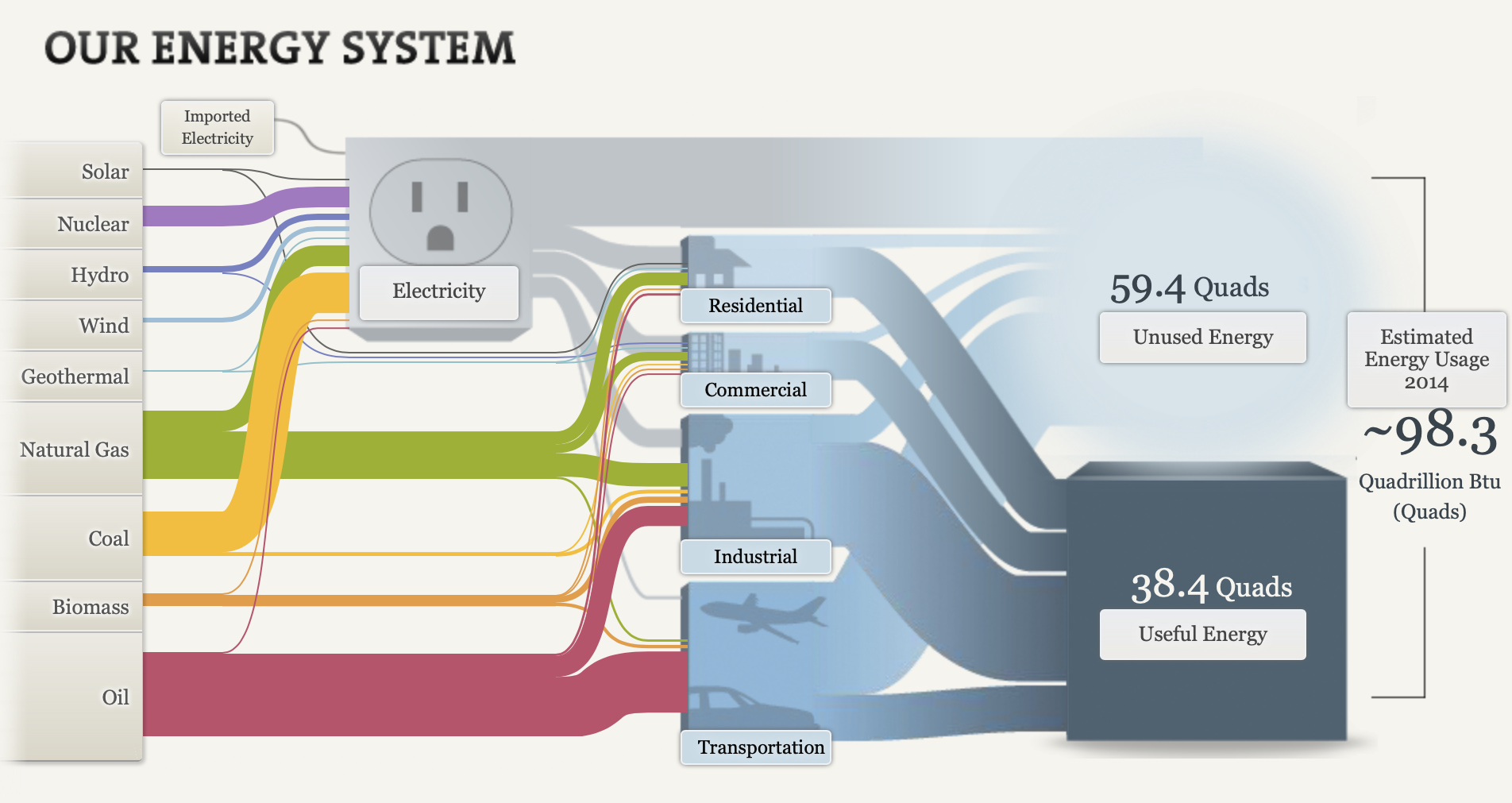Sankey Visualizations
I think the Sankey graphics have some upsides and downsides. I like the interactivity of the website, and I feel like in certain ways it can give you a good perspective of the energy breakdown nationally and regionally but other places it starts to faulter. In particular I don’t like the vagueness of how certain energy streams translate to used and unused power. In the first picture you can see that geothermal energy accounts for an extremely low percentage of total energy usage nationally, but then the avenues that it goes down have varying degrees of how much power is unused. When you have this discrepancy it’s hard to tell how efficient each power source actually is.

I do like the energy breakdowns for the regional map because I think this chart makes it easy to draw some conclusions about the plausibility of renewable energy reliance. As a disclaimer I am a large proponent of sustainable energy conversion, however, I think from the below two pictures you can see that this isn’t an easy task. Especially when you look at where the sources are going. The transportation sector is still dominated by oil, so there is a significant amount of progress that needs to be made in creating more efficient energy systems that can support the use of clean energy.


In conclusion I think that this website does some things right and some things wrong. A chart is supposed to guide the audience through the data that’s compiled, but I found myself questioning how accurate the numbers were, and without a lot of context for how much energy “.9” or “300” meant, it was hard to see the magnitude of differences. In terms of layout I thought the chart did a good job of graying out what wasn’t being actively clicked on, and that helped guide my eye through the different pathways that would otherwise be tangled up with each other.
-Jack Swenson
Sankey: Our Energy System
This interactive data visualization tool was very fun to explore. There was a lot of really good information all packed neatly into a tight and organized visualization. It was also a really good tool to compare energy sources from different areas.
California is very anti-coal use and this graph really shows it. It gets more interesting to me when you can see the coal use in other stats such as OH, MD, WV, Pa regions.
Using those same comparisons, it is also interesting to see how much more oil California uses than Md, OH, PA, WV region.
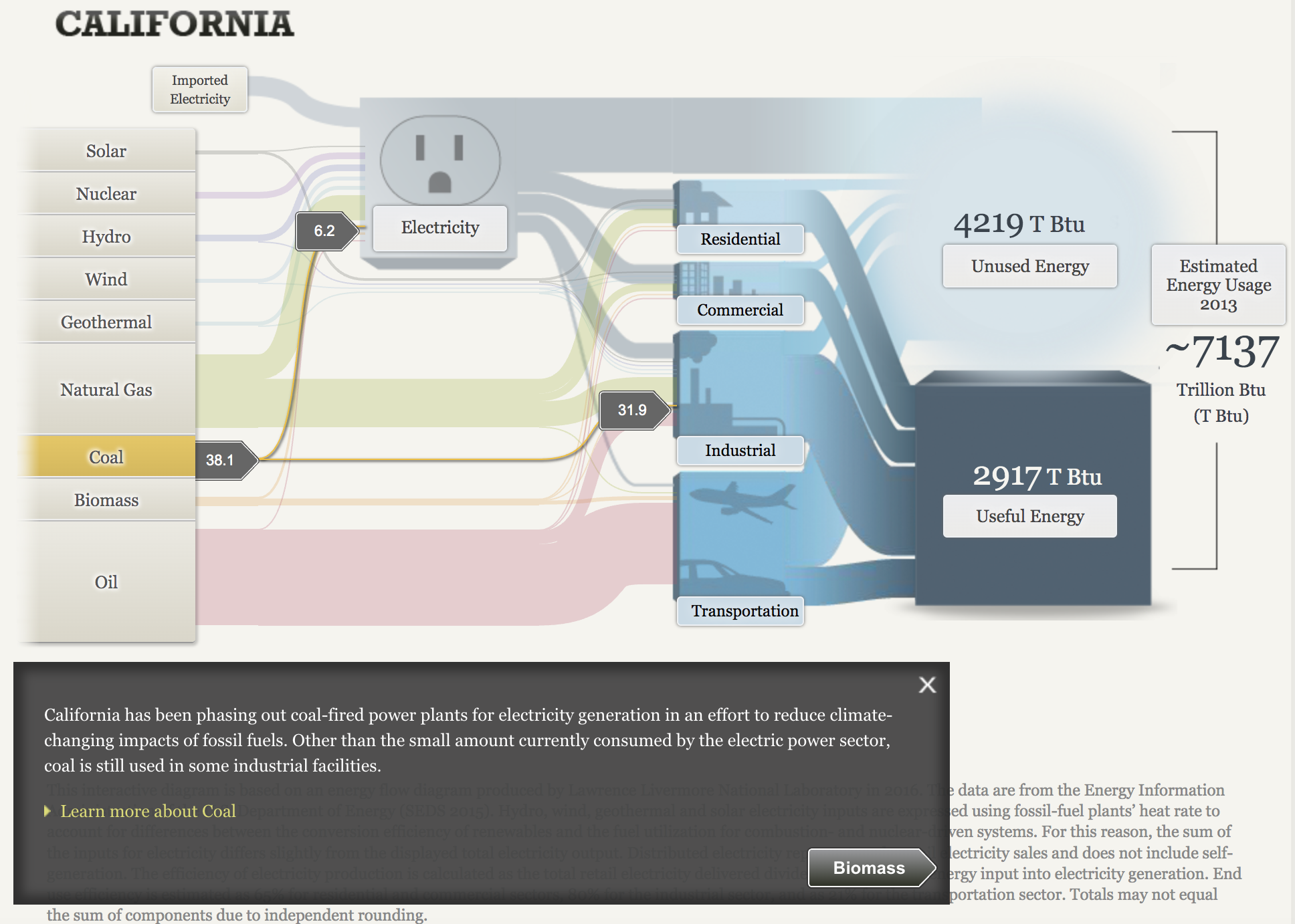
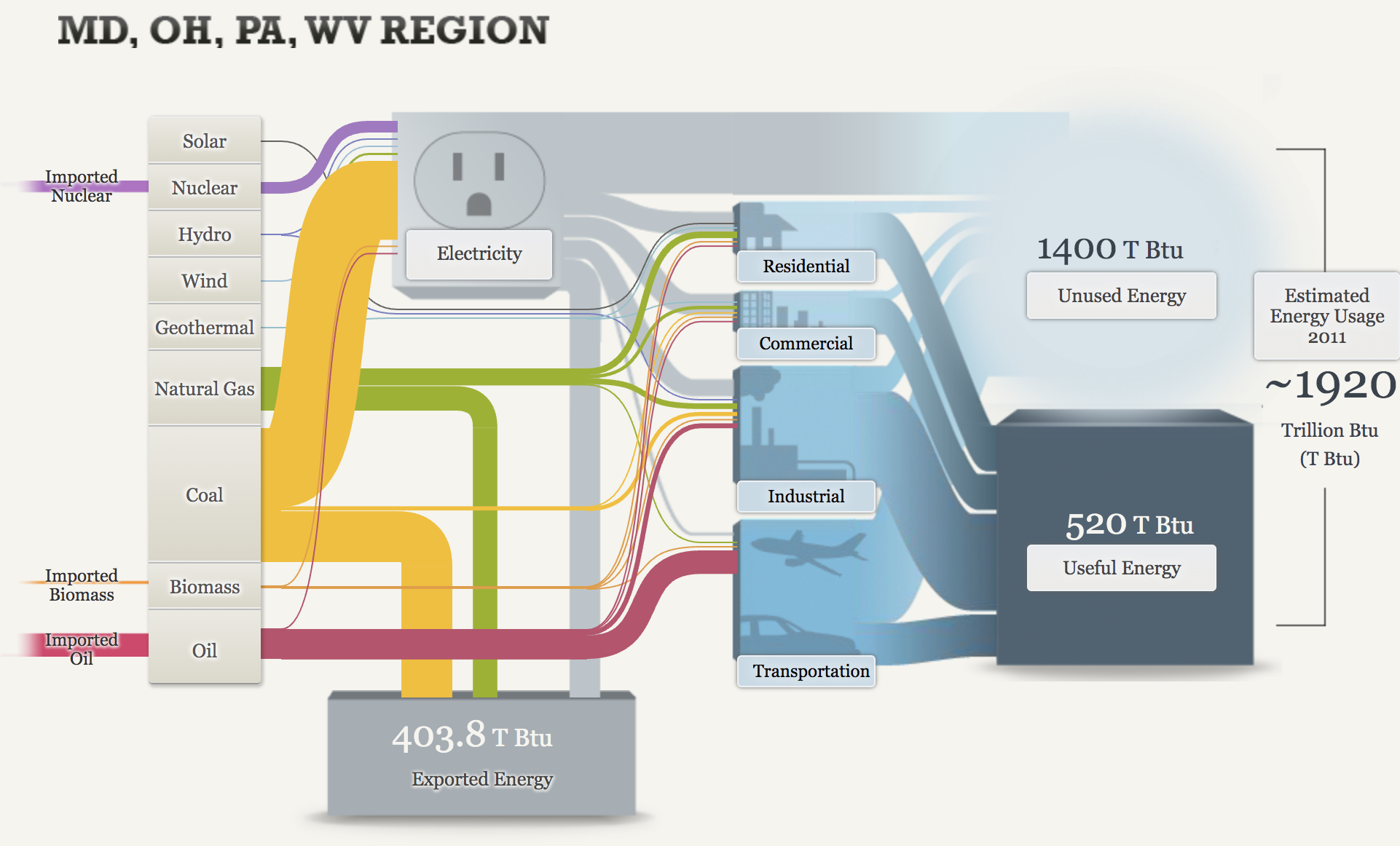
Sankey Visualizations
A Sankey Diagram is a visualization that Is used to depict a flow from one set of values to another. They help locate the most important contributions to a flow. Sankey visualizations are best used when the topic is energy, time, or money.
Although there is a ton of information presented in this visualization and it seems cluttered, I think this is the most effective way to view this data. This visualization is super effective considering that there are so many different aspects on this chart that are combined into one piece. Firstly, the energy system is broken down into the types of energy on the left hand side. The visualization allows you to click on each tab. When you click on each type of energy, it shows you what percentage of energy is expended and where it goes. For example, when you click on solar energy it shows you that solar energy accounts for 0.42% of all energy expended, and that 0.17% goes to electricity, and 0.25% goes to residential use. The infographic then breaks it down even more. It shows the amount of energy that is unused, and used from each category (electricity, residential, commercial, industrial, transportation). The thickness of the flow indicates the amount of energy. For example, you can see that most of the energy from transportation is unused because a larger flow moves from transportation to unused energy. All in all, there is so much information that can be digested from this visualization. It appears to be a lot, but when you break it down into pieces it is very effective. I believe this is the best way to display this information.
SANKEY
After playing around with the simulators within our energy system on National Academics: What You Need To Know About Energy, I am actually quite shocked. Within their page, there are multiple different walkthroughs of how to conserve wasted energy at home and even on the road. When I first started going through the pages, the first one that popped up stuck out to me.
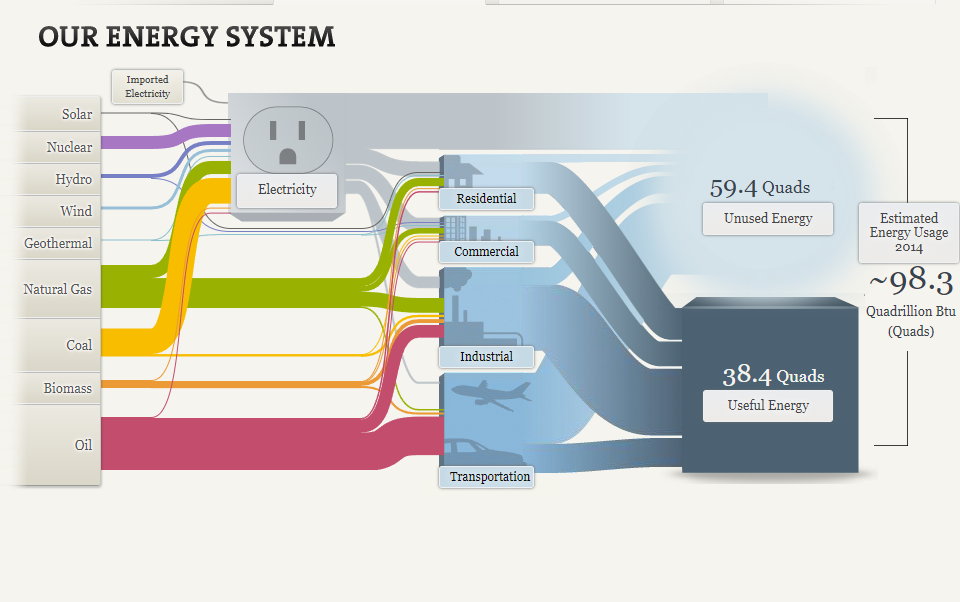
The picture above is one of the simulators on their website that shows you our energy system. Each category of energy is on the left side and it shows you where it goes to. What blew my mind was in the end, there were 38.4 Quads of useful energy, but there were 59.4 Quads of unused energy. Keep in mind “quads” is really quadrillion BTU. This is more than the used energy! I also liked how within this visualization, each category had a different color so you could see exactly where it goes to. For example, Natural Gas which is the color green goes to Industrial, commercial, and residential.
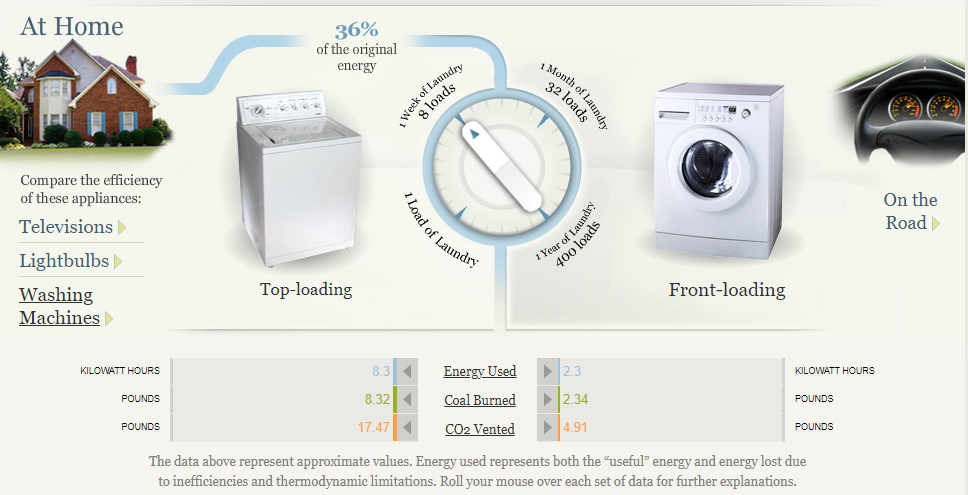
Another part of this website that I thought was beneficial, was the ways to conserve energy at home and on the road. Within the at-home section, you could choose between television, lightbulbs, and washing machines. I decided to play around with the washing machines page, which I thought was really cool. Washing machines were reported to use 36% of the original energy. You can turn the dial to either one load of laundry or 1 week of laundry. You could do the same with 1 month, and 1 year. You can see on each one how much energy you use, how much coal burns, and the CO2 vented between Top-loading and front-loading. This website is definitely beneficial to someone who could be looking to learn more about ways to conserve energy and interact with different pages of useful information.
Sankey Visualizations
By John Wickham
As a person who likes a good chart, I am always open for suggestions that can make work better. This is why the use of Snakey would catch my eye to know if I could use it.
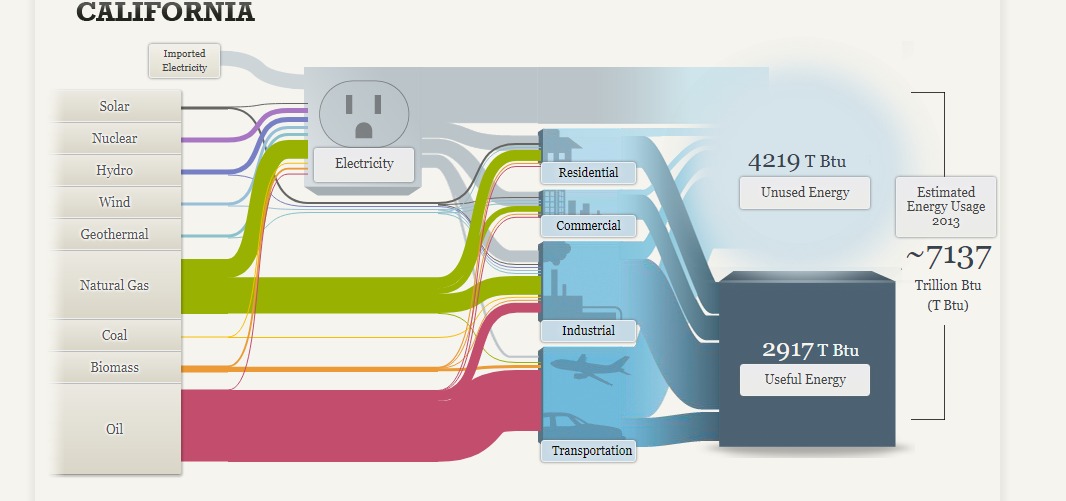
The chart above shows the information of the use of power that people from California use. You can see the huge amount of oil that people use in the largest state. There is the fact that there is only small string for Coal use, which is important to notice for coal supporters. The main source of worry is the small amount of power that is generated from alternative sources like wind, water, or solar. It worrys me.
The one complaint that I have is that this chart is very busy. It is hard to interpret data without taking some time to understand. You can get it, but it takes some effort.
Sankey Visualizations
With Sankey Visualizations being a technique that helps the user to displays flows within data, it is a very helpful tool when trying to string many different charts and diagrams regarding the same topic together.
While reading through the site talking about our energy system I noticed how many different pieces of information were available to me on just one of the pages. I did like how this site was formatted but there was one thing that I feel like could make the site too crowded.

Within just this page from the complete site there are 17 different things that the reader can click on that reveal even more information to them. While I do understand that this is the information they are provide, I feel that separating it even more will help the reader not miss any points of information if they don’t click on every single tab per page.
Sankey Visualization
By Nick Ligameri
According to www.ifu.com, a Sankey diagram is a “specific type of flow diagram used for visualization of material, cost or energy flows. They show energy or mass flows with arrows proportional to the flow quantity. They have directed arrows featuring flows in a process, production system or supply chain.” Given this definition, it is easy to understand why this visualization was chosen to represent the flow of energy within our country.
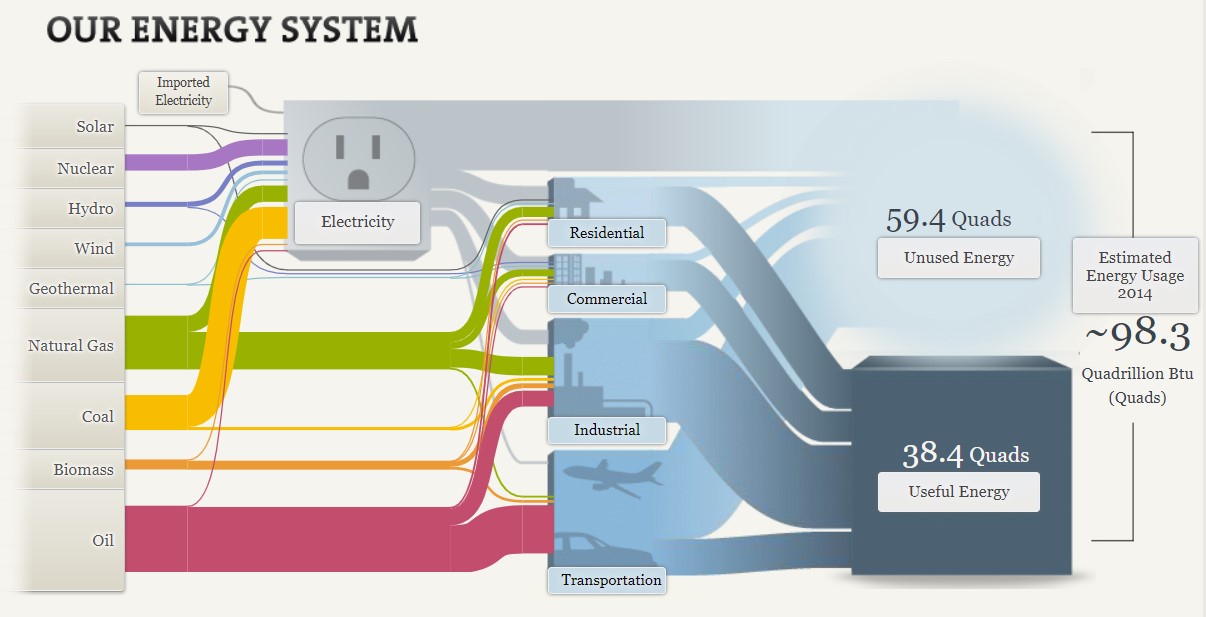
The above Sankey visualization does a wonderful job at taking a complex dataset and showing not only how much of each resource is used, but where it is used. At a glance, the visualization does seem a bit messy, but I like to think of it as organized chaos. What I like about this is that you can quickly see what resource we utilize the most and, more importantly, what industries have the most waste.
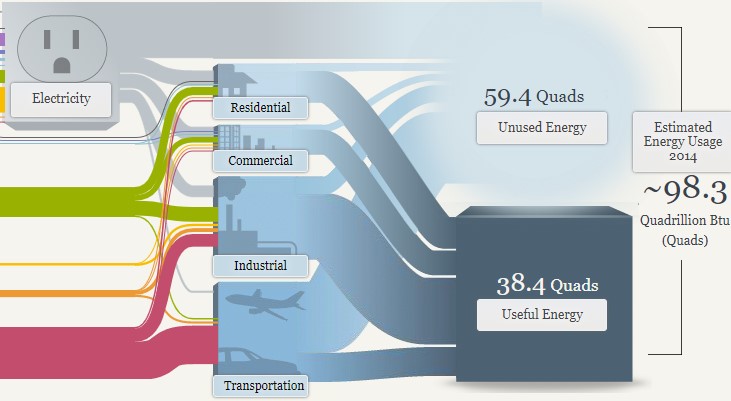
In the above image, you can see that the most waste is generated from electricity and the transportation industry. When you click on the Unused Energy button, it explains that the waste comes in the form of heat that is generated when converting energy into a different form of energy. It is striking that we produce more wasted energy than we consume. From this diagram, you can quickly determine the need to produce a more efficient energy source.

This website also shows two different energy systems besides the national system. My immediate thought was to compare these two systems. To do that, I had to click back and forth between each page. I think this tool would be even more powerful if the author could have provided an easier way to compare the two. This is even more important considering that California consumes roughly three times more energy than Maryland, Ohio, Pennsylvania, and West Virginia combined. I would want to highlight this somehow, possibly with some variation of a column or bar chart.
Overall, I feel this Sankey visualization does an effective job of communicating a complex story in a relatively simple way. The user interactions feel intuitive and lead the viewer along. This type of visualization seems like it would be difficult to learn how to build, but completely worth the effort.
SANKEY VISUALIZATIONS.
Sankey Diagram is a visualization technique that allows the display of flows. Many experts argue that Sankey diagrams do a better job than pie charts, visualizing flows in their proportions. The things connected are called nodes and the connections are known as links. Sankey diagrams are also perfect for showing many-to-many mapping relationships.
They are very good at showing particular kinds of complex information:
- Energy flow
- Budget flow ( where the money came from and went to
- Number of people migrating from one country to another
- The flow of goods from one place to another
SANKEY VISUALIZATIONS – OUR ENERGY SYSTEM
A Sankey diagram was used to visualize the primary energy source supply directly to the residential, industrial, commercial, and transportation sectors in the USA. It also showed how electricity was generated from a list of primary sources.
The diagram appeared complex at first view but very with careful observation, it gives out detailed information.

The Sankey diagram shows the primary sources of energy: solar, nuclear, hydro, wind, geothermal, natural gas, coal, biomass, and oil. The colored links show the flow of energy from these primary sources to their destinations: residential, commercial, industrial and transportation uses. The width of the links shows the proportion of energy flow to its primary source.

The visualization allows you to click on a primary “source of energy” to examine its “flow of energy.” It places the other categories in the rear and reduces the clutter of information. The use of labels also helps ascertain the value of the amount of energy flowing from the primary source to its destination.
Sankey diagrams can be very effective in displaying visual information about complex data. The caveat is to be very cautious of cluttering information due to its complexity.
Sankey
Sankey is a chart or a visualization that shows off the gradual progress of something. this type of chart is ideal for showing off the process of an event, the history of a certain topic, or the rise of a movement. It is a good way to show the continual progress of something in an interactive way.
This visualization is showing the audience how energy is used throughout the US.
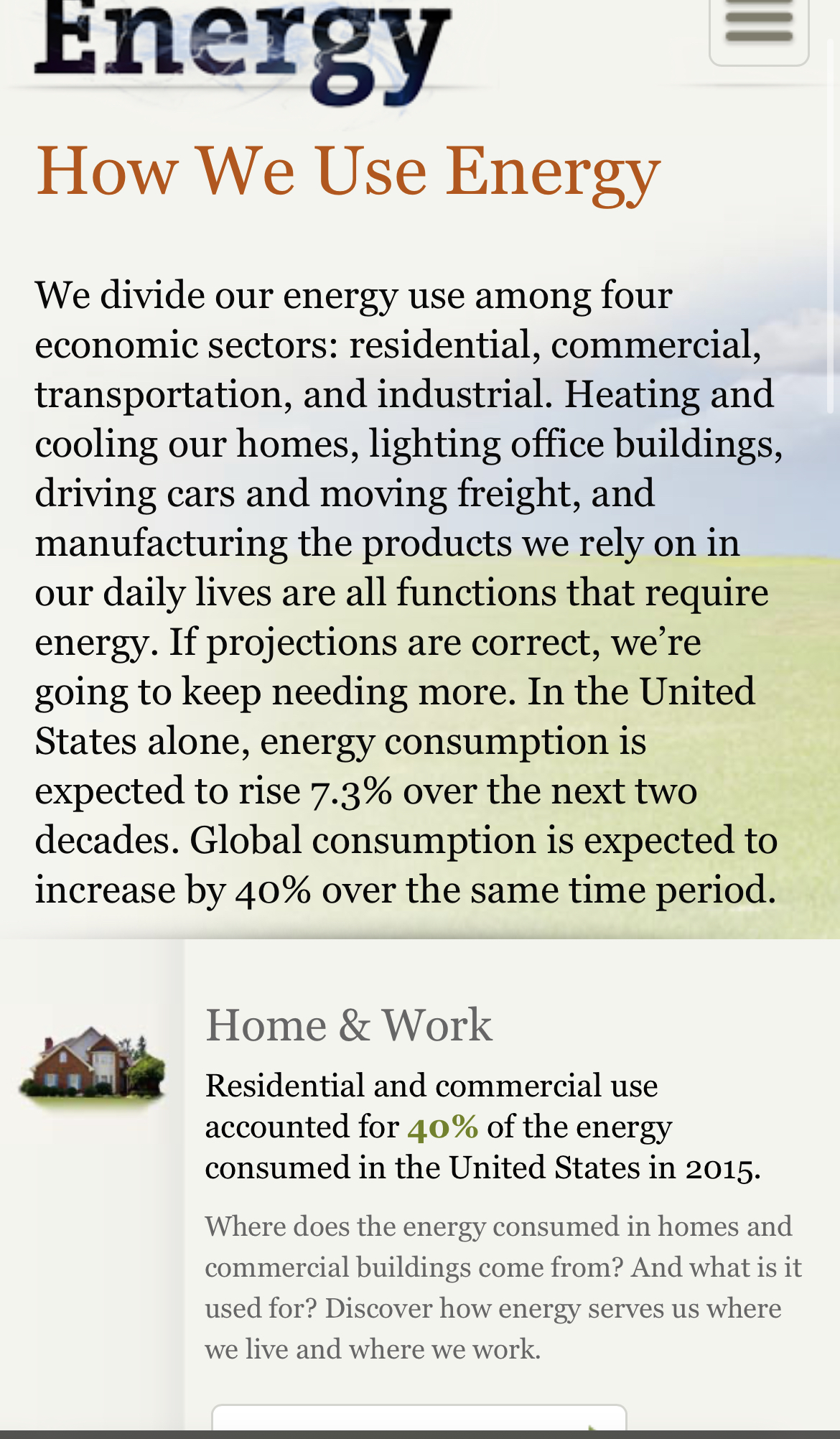
The site has a tab that shows in great detail the nuances of the US energy system and all the intricate parts attached to it. For example, one of the visualizations shows off how much energy overall the US population consumes in one year.
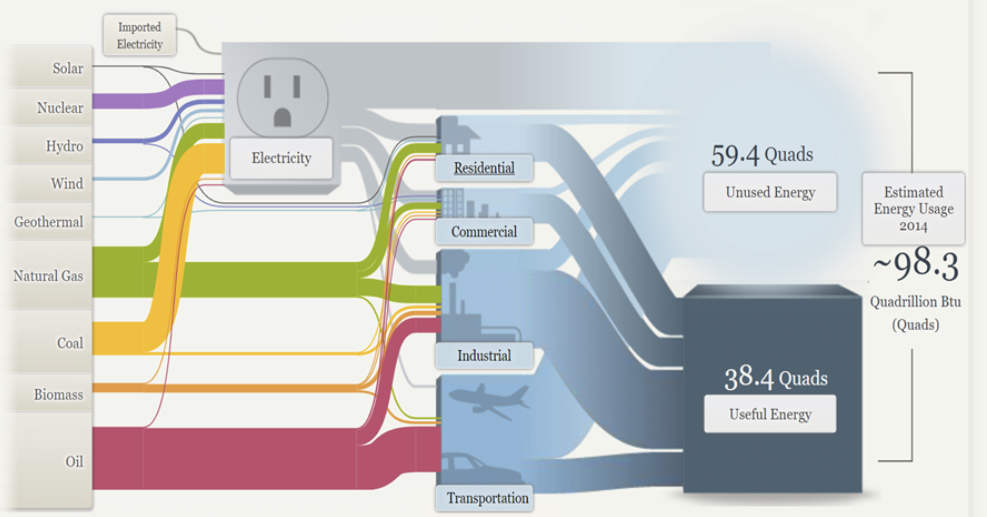
Overall, Sankey Visualizations create an innovative and new way to present presentations. They give the audience a chance to dive into the subtopics of a subject and weave passageways of information. I believe that this is the kind of presentation that would be excellent for an audience that is eager to comprehend the complexities of a topic.
Sankey
This Sankey Visualization is in interaction visualization that shows how our energy system works in the US and how how it is used throughout the company. This tool is a great way to display this type of information. Being that it is interactive, you are able to click your way through and learn about the Energy System.

The column on the left side is interactive and shows information bases off of each tabs topic. Depending on which tab you click on, the information is unique that that tab and shows different numbers and links to the column in the middle. This shows which tabs down the left are connected to the tabs down the middle. While clicking through all the tabs, little blurbs pop up explaining each tab and the number in detail.
Sankey Visualizations are great tools to use to display this type of data such as how things work, and how subcategories of certain topics are linked to each other and all equate to one thing. Sankey Visualizations show how a topic’s information can relate to other topics that show the general idea of something. I think they are very easy and simple to follow. They are also not overwhelming to look at because there is information hidden in each tab with a link to explain the information in more detail.
